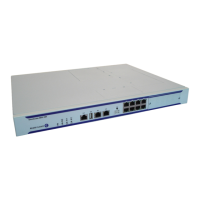IES Service Configuration Commands
Page 800 7750 SR OS Services Guide
policy
Syntax policy vrrp-policy-id
no policy
Context config>service>ies>if>vrrp
Description This command creates VRRP control policies. The VRRP policy ID must be created by the policy
command prior to association with the virtual router instance.
The policy command provides the ability to associate a VRRP priority control policy to a virtual
router instance. The policy may be associated with more than one virtual router instance. The priority
events within the policy either override or diminish the base-priority dynamically affecting the in-use
priority. As priority events clear in the policy, the in-use priority may eventually be restored to the
base-priority value.
The policy command is only available in the non-owner vrrp virtual-router-id nodal context. The
priority of owner virtual router instances is permanently set to 255 and cannot be changed by VRRP
priority control policies. For non-owner virtual router instances, if the policy command is not
executed, the base-priority will be used as the in-use priority.
The no form of this command removes any existing VRRP priority control policy association from
the virtual router instance. All such associations must be removed prior to the policy being deleted
from the system.
Default None
Parameters vrrp-policy-id — The vrrp-policy-id parameter associated the corresponding VRRP priority control
policy-id with the virtual router instance. The vrrp-policy-id must already exist in the system for
the policy command to be successful.
Values 1 to 9999
preempt
Syntax preempt
no preempt
Context config>service>ies>if>vrrp
Description The preempt command provides the ability of overriding an existing non-owner master to the virtual
router instance. Enabling preempt mode is almost required for proper operation of the base-priority
and vrrp-policy-id definitions on the virtual router instance. If the virtual router cannot preempt an
existing non-owner master, the affect of the dynamic changing of the in-use priority is greatly
diminished.
The preempt command is only available in the non-owner vrrp virtual-router-id nodal context. The
owner may not be preempted due to the fact that the priority of non-owners can never be higher than
the owner. The owner will always preempt all other virtual routers when it is available.
Non-owner virtual router instances will only preempt when preempt is set and the current master has
an in-use message priority value less than the virtual router instances in-use priority.
A master non-owner virtual router will only allow itself to be preempted when the incoming VRRP
Advertisement message Priority field value is one of the following:

